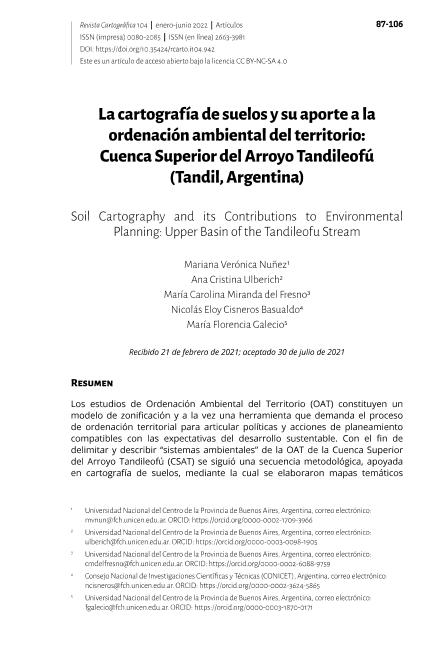Artículo
Los estudios de Ordenación Ambiental del Territorio (OAT) constituyen un modelo de zonificación y a la vez una herramienta que demanda el proceso de ordenación territorial para articular políticas y acciones de planeamiento compatibles con las expectativas del desarrollo sustentable. Con el fin de delimitar y describir “sistemas ambientales” de la OAT de la Cuenca Superior del Arroyo Tandileofú (CSAT) se siguió una secuencia metodológica, apoyada en cartografía de suelos, mediante la cual se elaboraron mapas temáticos intermedios y un mapa de OAT que integra los anteriores. La secuencia comenzó con la Zonificación Morfológica Superficial, a lo que le sucedió la Zonificación Edáfica derivando en la Zonificación Morfoedáfica; a esta última, se la correlacionó con la vegetación, resultando el mapa de Zonificación MorfoFitoEdáfica o Zonificación Ecológica; luego, se incorporó el Uso Actual de las Tierras (UAT), lo que permitió analizar las relaciones sociedad-naturaleza en la CSAT e identificar potenciales problemas ambientales producto de esta relación y elaborar el mapa de OAT de la CSAT. Los resultados obtenidos posibilitaron interpretar la heterogeneidad interna de los sistemas ecológico-paisajísticos y obtener siete subsistemas ecológicos; el estudio y mapeo del UAT demostró que las tierras están principalmente ocupadas por actividades agropecuarias mixtas (46,4%), agrícolas (31,3%) y tamberas (12,4%); la OAT de la Cuenca permitió obtener 16 tipos de unidades cartográficas que describen entidades territoriales con restricciones y potencialidades ecológicas de cada paisaje/ sitio, con la estructura espacial y funciones de tipos y formas del UAT. A modo de conclusión, es posible inferir y correlacionar la información topográficopaisajística analizando las cartas de suelos y las descripciones de cada sistema y subsistema representados en ellas; la metodología propuesta enfatiza y pone en valor el uso de los recursos y productos que surgen de la Ciencia Cartográfica en las tareas de gestión y planificación territorial. The Environmental Planning studies of the Territory (EPeT) provide a zoning model and at the same time a tool that demands the territorial planning process to articulate policies and planning actions compatible with the expectations of sustainability. In order to delimit and describe “environmental systems” (EPeT) of the Upper Arroyo Tandileofú Basin (study area), a work was carried out supported by soil cartography. For this work a methodological sequence was followed developing intermediate thematic maps up to the Environmental Planning studies of the Territory map that integrated the previous ones. The methodological sequence began with the Superficial Morphological Zoning, followed by the Edaphic Zoning. These maps derived from the Morphoedáphic Zoning. The latter map was correlated with vegetation, getting the MorphoPhytoedic Zoning or Ecological Zoning. Then the Current Land Use (CLU) was incorporated. This made it possible to analyze the relationship between society and nature in the study area and to identify possible environmental problems derived from this relationship, and prepare the (EPeT) map of the study area. The results obtained: -made it possible to interpret the internal heterogeneity of the ecological-landscape systems and obtain 7 ecological subsystems; -the (CLU) study and mapping showed that the lands are mainly occupied by mixed crop-livestock farming (46,4%), crop activity (31,3%) and dairy farm activity (12.4%); -with the (EPeT) of study area they were obtained 16 types of cartographic units that describe territorial entities with ecological restrictions and potentialities, with the spatial structure and functions of types and forms of the (CLU). In conclusion, it is possible to infer and correlate topographiclandscape information by analyzing the soil cartography and the information of each system and subsystem represented, and the methodology highlights the use of resources and products that arise from Cartographic Science in territorial management and planning tasks.
La cartografía de suelos y su aporte a la ordenación ambiental del territorio: Cuenca Superior del Arroyo Tandileofú (Tandil, Argentina)
Título:
Soil cartography and its contributions to environmental planning: Upper Basin of the Tandileofu Stream
Nuñez, Mariana Veronica ; Ulberich, Ana Cristina; Miranda del Fresno, María Carolina; Cisneros Basualdo, Nicolás Eloy
; Ulberich, Ana Cristina; Miranda del Fresno, María Carolina; Cisneros Basualdo, Nicolás Eloy ; Galecio, María Florencia
; Galecio, María Florencia
 ; Ulberich, Ana Cristina; Miranda del Fresno, María Carolina; Cisneros Basualdo, Nicolás Eloy
; Ulberich, Ana Cristina; Miranda del Fresno, María Carolina; Cisneros Basualdo, Nicolás Eloy ; Galecio, María Florencia
; Galecio, María Florencia
Fecha de publicación:
12/2021
Editorial:
Instituto Panamericano de Geografía e Historia
Revista:
Cartográfica
ISSN:
0080-2085
e-ISSN:
2663-3981
Idioma:
Español
Tipo de recurso:
Artículo publicado
Clasificación temática:
Resumen
Archivos asociados
Licencia
Identificadores
Colecciones
Articulos(CCT - TANDIL)
Articulos de CTRO CIENTIFICO TECNOLOGICO CONICET - TANDIL
Articulos de CTRO CIENTIFICO TECNOLOGICO CONICET - TANDIL
Citación
Nuñez, Mariana Veronica; Ulberich, Ana Cristina; Miranda del Fresno, María Carolina; Cisneros Basualdo, Nicolás Eloy; Galecio, María Florencia; La cartografía de suelos y su aporte a la ordenación ambiental del territorio: Cuenca Superior del Arroyo Tandileofú (Tandil, Argentina); Instituto Panamericano de Geografía e Historia; Cartográfica; 104; 12-2021; 87-106
Compartir
Altmétricas



